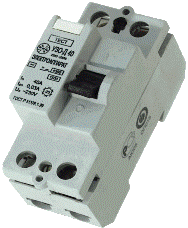Categories: Novice electricians, Electrician at home
Number of views: 247,645
Comments on the article: 7
How to connect an RCD
 Any leak is an undesirable occurrence. In the normal mode of operation of an electrical system, current should flow only through electrical circuits relative to phases and zero (figuratively speaking). The resulting current relative to the ground will be this same leak. It can occur as a result of a breakdown on the case, which is initially grounded, if a person accidentally touches a person carrying parts (leakage current will pass through the body of this person), obsolescence of the wiring, etc.
Any leak is an undesirable occurrence. In the normal mode of operation of an electrical system, current should flow only through electrical circuits relative to phases and zero (figuratively speaking). The resulting current relative to the ground will be this same leak. It can occur as a result of a breakdown on the case, which is initially grounded, if a person accidentally touches a person carrying parts (leakage current will pass through the body of this person), obsolescence of the wiring, etc.
The best connection option RCD (residual current device) there will be maximum proximity to the power input. Since the gap between the power supply network and the electricity meter is subject to strict control of electric power organizations, it is more correct to install an RCD immediately after the counter. This ensures complete protection against all kinds of earth leaks throughout the circuit.
The disadvantage with this connection of the RCD is the de-energization of the entire electrified zone that passes through this protection. In case of critical undesirability of such a phenomenon, it is necessary to install either several RCDs or deliver only for that section (for that circuit) which is most significant and important from the point of view of electrical safety (although, electrical safety needed everywhere).
The figure shows RCD connection diagram, which is most often applied in practice. On the right side is a general diagram of the internal structure of this protection. And so, the RCD is a residual current device or, as it is also called, “differential protection”. Its main task is to automatically turn off the power supply when a leakage current to the earth occurs.

Connection diagram of the residual current device (RCD)
Now for the RCD itself. The basic principle of operation of the residual current device is to monitor the difference in current between the neutral and phase wires. With the nominal operation of any device and electrical equipment, this difference cannot exist (that is, how much current passed through the phase wire, the same amount will pass through the zero wire).
Suppose that the wiring is in a damp room and there are damage to the insulation (cracks) in it. Moisture got through the crack to the current-carrying core, thereby creating a circuit between this wire and the ground. As a result, this same leakage current will be the difference to which the RCD must respond.
Further, the current of this leakage was taken from one of the coils of the internal transformer and transmitted to a polarized relay. In it, the signal amplifies, and launched the RCD disconnect mechanism. Thus, until this same wiring fault is found and fixed, the residual current device will be knocked out again at the next platoon.
 Since any device tends to break down sometimes, then an RCD will be no exception. In this case, a test function (self-test) is provided. On the front side of the RCD there is a test button. When it is pressed, this leakage current is simulated, which leads to automatic operation and subsequent shutdown. If you suspect a malfunction of the differential protection device or just for a regular check, do not be lazy, and click on the test button.
Since any device tends to break down sometimes, then an RCD will be no exception. In this case, a test function (self-test) is provided. On the front side of the RCD there is a test button. When it is pressed, this leakage current is simulated, which leads to automatic operation and subsequent shutdown. If you suspect a malfunction of the differential protection device or just for a regular check, do not be lazy, and click on the test button.
It is advisable to connect the residual current device following the inscriptions on the body of the RCD itself. As shown in the figure, the device has contact neutrals that connect to zero and phase contacts, which are most often indicated by the numbers 1 and 2 or L (although phase ones are sometimes not indicated at all).
The figure shows the connection diagram of the RCD for a single-phase consumer, but of course there are RCDs and three-phase ones. The only difference is only in the number of contacts. The general essence of connecting and working remains the same.We screw the neutral wire to the neutral, and, of course, three phases to the three phase contacts.
And the last thing that can be said about RCDs - it is advisable to install them in those places where it is necessary to ensure high electrical safety. In those places where an accidental shutdown can lead to undesirable consequences, differential protection is perhaps better not to set. Despite the main task of RCDs to ensure electrical safety, in practice it often brings additional problems.
Leakage currents in worn-out electrical equipment are common (example: old lights that work in non-buildings). RCD is very sensitive to such things. As a result, you are tormented by the constant operation of this protective device. You will either have to abandon the RCD, or replace all the old electrical equipment with wiring with a new one. Which is cheaper and safer is up to you.
Alexander Viryukhalov
See also on this topic: Schemes for connecting RCDs and differential machines
Helpful information:Proper operation of electrical equipment and wiring in a country house
See also at bgv.electricianexp.com
:
